Almonds are the fruit produced by Almond trees (Prunus dulcis). Shelling Almonds mainly refers to removing the shell to reveal the seed. Almonds are mostly sold shelled or unshelled. The Almond tree is a fruit tree native to Middle Eastern countries. These trees belong to the same genus as peach trees. They are considered nuts; Almonds are technically a type of stone fruit called a drupe. Drupes are fruits made up of an outer hull and a hard shell that contains the seed.
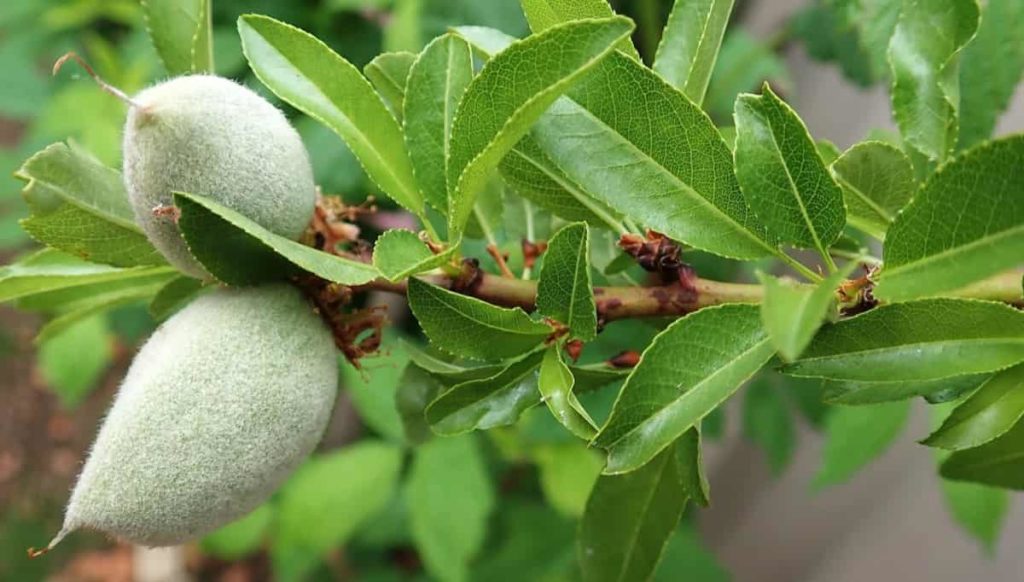
Almond Farming/Production in the USA
In what zones do Almond trees grow?
Almond trees prefer warm climates. Therefore, most Almond varieties grow well in zones 5 through 9.
Cost of starting an Almond farm
Established Almond orchards in this region cost $30,000 to $40,000 per acre, depending on irrigation availability, tree age, average yield, soil quality, and various other factors.
Types of Almonds grown in the USA
The main types of this group are Butte, Padre, Butte/Pedre, and Fritz. Over the years, Butte, Padre, and Fritz have also been sold under the “California” variety because they share a characteristic that defines the variety. 49 varieties of Almonds are grown in the United States. Four varieties account for 85 percent of all Almonds grown in California. The four main varieties are Non-Pareil, Carmel, California, and Mission.
- Non-Pareil – These Almonds have a thin outer shell and a smooth, light-colored kernel, making them easy to clean. If you want a good-looking smooth-kernelled Almond that is somewhat flat, non-pareil is the variety to buy.
- California – This category includes several varieties. They have a hard shell but are still easy to blanch. Some varieties in this category include Carmel, Monterey, and Sonora Almonds. California Almond variety has a wide range of shell hardness, kernel shape, skin color, and surface characteristics. They are quite adaptable and suitable for almost any process or application. Some examples include but are not limited to Aldrich, Carmel, and Monterey.
- Carmel – Carmel is one of the smaller varieties of Almond and is not as wide as tall. Popular in home gardens, these trees are naturally compact and easy to prune.
- Mission – Almonds classified in this classification have a really hard shell. The inner kernel is smaller than Non-Pareil and California Almonds. Mission Almonds have dark, wrinkled skin, making them a great choice for flavored Almonds. Producers usually do not blanch this variety of Almonds because of the dark wrinkled skin.
Mission Almonds have hard shells; their kernels are small, broad, and plump. The kernel’s skin is usually darker and more wrinkled than the non-pearl, which increases salt and flavor retention. Blanching is not that common for this variety. Examples of Mission types include Butte, Fritz, and Padre.
Non-Pareil Almond trees bloom first, and the fruit ripens earlier than other types of Almond trees. Other varieties may take 25 to 60 days before the nuts are ripe enough to harvest. Other major categories include “Price” (5%), “Butte” (5%), “Ne Plus Ultra,” “Merced,” and “Peerless” (about 3% each) and about 40 others. The average Almond yield per hectare is more than 1.3 to 1.5 of shelled products.
Almond growing regions in the USA
California produces about 80% of the world’s Almonds and 100% of the US commercial supply. Almonds are California’s #1 agricultural export. Almonds are grown primarily in Kern, Merced, Fresno, Madera, Stanislaus, and San Joaquin counties in the San Joaquin Valley and Butte and Colusa counties in the Sacramento Valley. The most widely grown variety of Almonds is the non-pearl, which accounts for 45% of the total production. Other popular Almond tree locations include Texas, Arizona, and Florida.
In case you missed it: Top 20 Steps to Boost Almond Yield: How to Increase Fruit Size, Quality, and Production
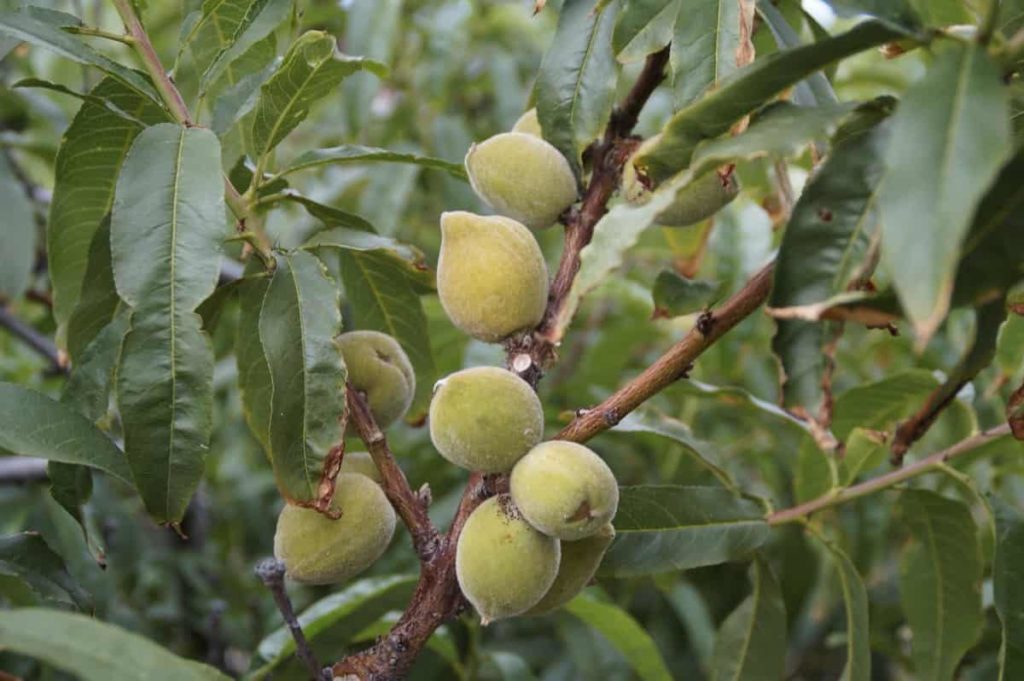
Soil and sun requirements for Almond farming in the USA
Soil conditions for Almond trees should mimic those in the Mediterranean. Soil should be well-drained, sandy, loamy, or loamy. Almond trees need at least five feet of topsoil, which you can use to build a mound around the trunk to help drainage. Almond trees grow best in soil with a pH level between 6 and 7 but don’t worry if you don’t find it perfect. They generally tolerate acidic, neutral, and alkaline soils.
Almond trees prefer full sun; they require at least six hours of direct sunlight daily. If your Almond tree absorbs more sun, you will get better blooms. If the sun is particularly hot where you live, paint the south side of the trunk with white latex paint to prevent sun-scorching.
Climate conditions for Almond framing in the USA
Like the Mediterranean, the ideal climate for Almond trees has hot, dry summers and mild but wet winters. The ideal temperature for Almond tree growth is between 15 and 30°C. It grows best in zones 7 through 9. In the United States, it includes the south-eastern states, Texas, the Southwest, and the coast of Washington, Oregon, and California in the west and Massachusetts to the coast in the east.
California has a Mediterranean climate, perfect for growing Almonds. Only five regions on Earth feature this climate outside the Mediterranean Sea, and California is one of them. Growing in California’s ideal Mediterranean climate, Almonds have many annual life stages and an abundance of natural beauty. Almond farming is a long-term commitment. Orchards produce for 25 years, with the first harvest three years after planting.
Almond trees thrive in Mediterranean climate conditions. They benefit from rainy winter weather but are highly susceptible to frost, making California the leading producer of Almonds in the United States. When deciding whether an Almond tree will work in your area, check your USDA plant hardiness zone—Almond trees do best in zones 7-9.
How to pollinate Almond trees in the USA
Most Almond varieties are not self-fertile. So they need cross-pollination to set fruit. However, an Almond tree theoretically needs only one grain of pollen from another compatible type at the right time to produce an Almond. All over the world, Almond growers rely heavily on strong and healthy bee colonies, which ensure the best possible cross-pollination.
The Almond grower should ensure that there is a large population of honey bees (2-3 strong colonies per acre or 5-7 per hectare) within the Almond orchard so that a single bee does not only pollinate different varieties of the same tree. While looking at the flowers, it will also transfer pollen to other trees of different species, usually located 20-30 feet away. Consequently, farmers often plant one row of pollinating-type trees for every three rows of main species.
But when one pollinator variety cannot ensure good cross-pollination due to inconsistent flowering, it is recommended to use two pollinator varieties, one early-flowering and one late-flowering, so that the flowering of both overlaps with the main types of flowering. Depending on the variety, the Almond tree blooms from late winter to early spring (during February in the US). The flowering period is highly dependent on weather conditions and can range from 4 to 30 or more days (the average flowering period is 25 days).
Almond growers must facilitate bee cross-pollination activity by eliminating all competing blooming weeds during the Almond flowering period. Otherwise, the bees will be distracted and visit the blooming grass; therefore, the cross-pollination of the Almond trees will be significantly reduced. In addition, frequent rains and cold weather during flowering usually impair bee cross-pollination activity, resulting in reduced fruit set and yield.
In some cases, if natural pollination of Almond trees is insufficient, commercial Almond growers may use artificial pollination methods. However, artificial pollination methods have not significantly increased Almond orchard yield. Like many crops, Almond cultivation requires cross-pollination. Although many insects pollinate Almonds, commercial Almond cultivation relies heavily on honey bees. Commercial Almond growers may rent hives during the blooming season to ensure pollination success.
California Almond growers began suffering from colony collapse disorder, an unsatisfactory phenomenon that resulted in a decline in bee populations. Although this increased pollination costs for many growers, the high demand for Almonds from the United States created an incentive to move bees to California. The state’s bee population has since partially recovered, accounting for more than half of all bee colonies in the United States.
In case you missed it: Organic Almond Farming -Production In India
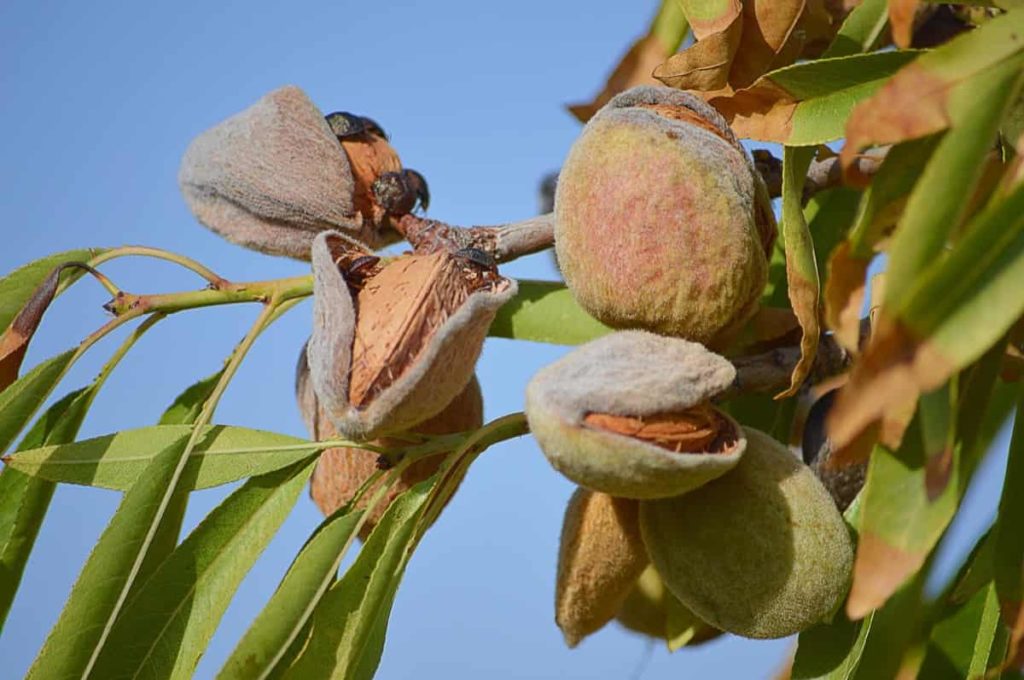
Irrigation management for Almond farming in the USA
Since California receives only rainfall, there is not enough to grow a commercially viable Almond crop, so growers need to supplement rainfall with irrigation. The common irrigation method was a flood irrigation system, where a farmer would flood the field and submerge all the trees. It allowed the farmer to save on expensive infrastructure costs such as underground pipes and micro-irrigation technology, realized when water was abundant and cheap.
However, as water has become scarcer and farmers have become more aware of their environmental impact, flood irrigation is rare. Rather, most Almond growers use highly efficient irrigation methods such as drip irrigation or micro-sprinkler irrigation. Unlike flooding, which has 50% efficiency, these new irrigation methods are as high as 95% efficient. In addition, some farmers take it further by using subsurface drip or deep-root irrigation.
These methods are also more efficient in reducing or eliminating water evaporation when irrigation is applied to the soil surface. Instead, the water is used to the roots directly below the soil surface. With increasing concerns over drought, water, and climate change, underground irrigation will become more popular in California. Many existing orchards converted to this technology to save water and increase efficiency.
Cultivation practices for Almond farming in the USA
The almond season begins in late October after the previous year’s harvest. During this time, it is essential to give the Almond trees enough nutrients before dormancy, so they are ready to push buds when they bloom in February. It mainly involves the application of nitrogen, potassium, zinc, and phosphate to the trees. These nutrients can be applied through irrigation water (often called fertigation), spread on the soil in dry form, or applied to the tree’s leaves in a foliar spray.
Around December, the Almond trees will lose all their leaves and become dormant. The trees will not take any nutrients or water during this time. Blooming occurs when Almond trees begin to put forth buds and flowers that need to be pollinated by bees so that the buds will eventually produce Almonds. During this time, it is essential that the air temperature does not get close to freezing, or it will kill the buds and significantly affect the crop.
Because of California’s mild winters, Almonds are more successful in this state than in other western states such as Arizona or New Mexico. As a result, the trees will produce leaves (leaves) and small nuts that eventually become the Almonds we eat. It usually happens in early March. It is also when irrigation water and additional nutrients are applied to the tree to size the Almond kernels and ensure they stay on the tree rather than falling off before they are fully ripe.
Water consumption increases gradually from March to July, peaking in July and then decreasing from July to October. From March to July, the Almond kernels increase in size. As a result, nutrition and water are critical during this time to ensure that there is enough energy to maintain the crop at the proper size. Many growers may also employ “deficit irrigation,” especially in years like this. Reduction irrigation is a method of reducing a tree’s water needs without necessarily affecting the crop.
Deficit irrigation is mainly applied after Almond kernels reach full size (in July) and can save 20% of water requirements during this period. In addition to nutritional requirements, Almond trees require fungicides and insecticides to protect the crop from diseases and pests. Basic fungal sprays are applied during bloom time in February. On the other hand, insecticides are mainly applied in summer to protect the crop from pests and marine orange moths.
Blooming stage in Almond trees
Between mid-February and mid-March, the Almond tree buds open into beautiful white and pale pink flowers. Orchards grow multiple varieties of Almonds, and beekeepers bring beehives into orchards to provide the missing piece of the puzzle. As the trees bloom, bees forage pollen and nectar in the garden.
In case you missed it: Almond Seed Germination, Time, Temperature (Badam)
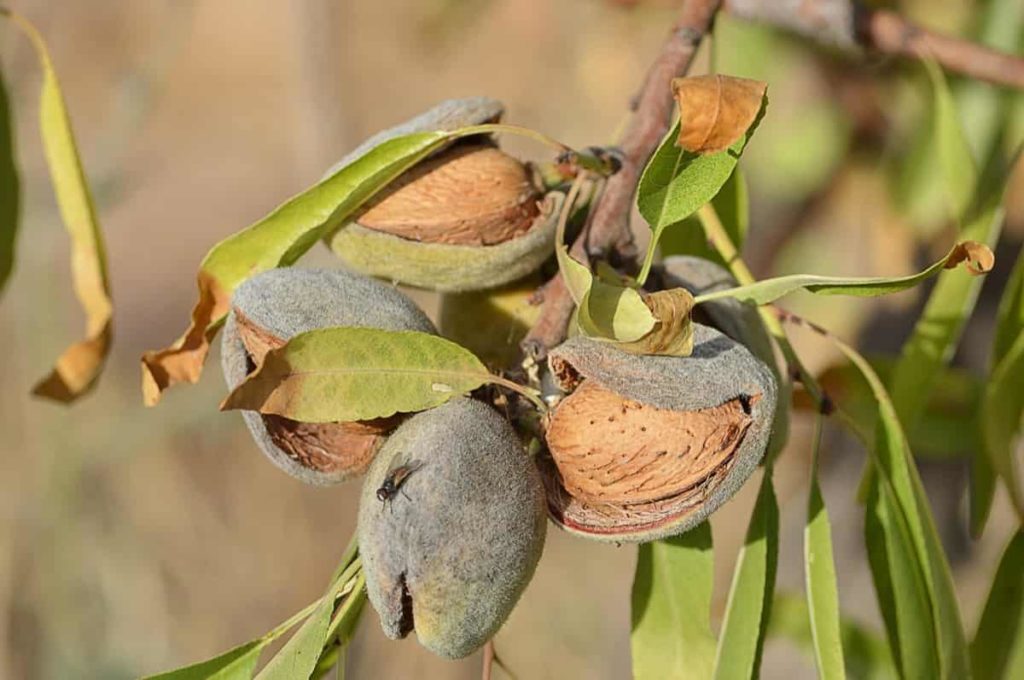
From March to June, the Almond kernel matures and grows to full size, and the shell around it hardens – both are protected by an opaque outer hull. Once the spring rains stop and the weather warms, farmers begin irrigating their fields to support the crop, taking great care to ensure that the water should be used efficiently. Also, green Almonds can be harvested for use in various foods.
Pests and disease control for Almond trees in the USA
Almond trees are mainly susceptible to many pests and diseases, the most common of which is the navel orange worm. It takes up residence in unharvested nuts on the tree during the winter. The best method to keep them away is to cut all the nuts off the tree. Almond trees are also vulnerable to peach tree borers. If your tree’s growth is stunted or you see insect infestation near its base, apply a Bacillus thuringiensis spray or Bt spray to kill them.
Protect your tree from diseases. Almond trees are prone to diseases when old, dirty garden tools damage their bark. Take extra care not to damage the trees during felling, and always use clean tools to cut them.
Almond tree management tips
Pruning encourages consistent, high production of good-quality nuts. It also removes branches growing in the working space between rows of trees. Pruning young trees helps them develop the desired shape and branch structure. As nut trees age, pruning is usually limited to removing dead or damaged branches unless better light penetration is needed. It is common practice to prune the Almond tree branches when planting.
It results in several shoots competing for the new leader’s position or main trunk. As a result, when new shoots are 8 – 12 inches tall, growers select the strongest and straightest as leaders and pinch the growing tips of competing shoots. The lower branches are shortened every year in late winter or early spring. If any lower branches grow vigorously during the growing season, the practice is to pinch off the growing point.
Leaving lower branches on a young tree helps it grow faster by maintaining its photosynthetic area. It also provides shade for the stem during the growing season. In addition, it facilitates weeding and other cultural practices.
Market standards for Almond trees in the USA
The USDA (United States Department of Agriculture) generally maintains grades for California Almonds that cover everything from defects to color. Higher grades, such as US Fancy, Extra No. 1, and US No. 1 (Supreme), require a stronger visual appeal. With a low level of chips or scratches (5-15%), only 1% of kernels must be split, and the sample contains less than 0.05% ‘foreign’ material.
Dust levels also need to be kept at a minimum of <0.1% in all grades, and crop management is critical in this regard. Grades like US No. 1 whole and broken, or US No. 1 pieces, accept high levels of chips, scratches, and broken nuts. However, the size of the nuts and the level of other defects are less important, and these Almond nuts are sold at a lower price for use in the manufacture of food ingredients.
Harvesting period for Almonds in the USA
From August to October, mechanical tree “shakers” harvest the Almond crop by shaking it vigorously into the ground. Protected by their outer holes and shells, the Almonds are dried naturally in the hot California sun for 7-10 days before being flown into rows by a “sweeper” machine. Then, a harvester or “pickup” machine moves over the rows, vacuuming the nuts into a cart that takes them to the edge of the orchard to take them to the next stop on their journey.
In case you missed it: Almond Oil Extraction Method, Process, Machine Cost
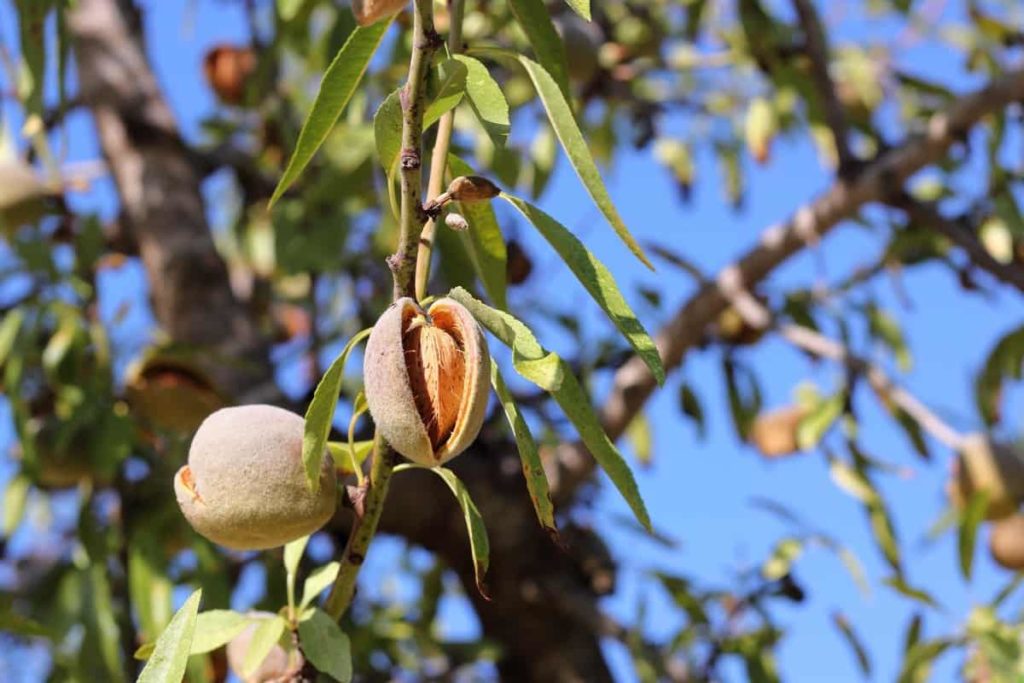
Each variety of Almonds is harvested separately, so this process usually happens two to three times per orchard. Also, during this period, Almond trees begin to form the buds that will become next year’s crop, so growers take care to give the trees what they need for this critical stage.
Frequently asked questions about Almond farming (FAQ)
Which state farms the most Almonds?
California produces about 80% of the world’s supply of nuts, which farmers have spent years learning to produce more with less water. So Christine Gemperl knew this would be a challenging year for her Almond crop.
How many Almond farms are there in the US?
Approximately 7,600 growers and 102 processors/handlers shipped 774 million pounds of Almonds.
Why are California Almonds cheap?
International demand for Almonds has increased recently and spurred significant crop growth in California. However, while groves expanded, California’s drought reduced supplies and drove prices above $4 a pound.
Which country produces the best quality Almonds?
The USA produces about 2,002,742 tons of Almonds of the best quality.
Where are Almonds grown in the US?
California produces Almonds commercially, where cool winters and mild springs allow Almond trees to bloom. As a result, 82% of the world’s Almonds come from California.
What is the price of Almonds in the US?
The average price per ton in New York and Washington is US$6018.01. The US import price of Almonds was US$8.45 per kilogram.
Can I grow an Almond tree in Texas?
Almond trees are generally unsuitable for growing in Texas because they bloom in early spring when frost damages the flowers or the nuts forming, Texas A&M University warns. However, varieties known as ‘Mission’ and ‘Halls Hardy’ bloom later and can reward you with a crop of Almonds in the fall.
Can Almond trees grow in Pennsylvania?
Although you won’t be able to grow Almonds here in western Pennsylvania, plenty of delicious, hardy nut trees are perfect for our climate.
Are Almonds grown in Tennessee?
Almonds are not suited to Tennessee’s growing conditions. Many of the others have specific characteristics that limit the areas of the state where they can consistently grow and fruit.
In case you missed it: Almond Farming, Planting, Care, Harvesting (Badam)
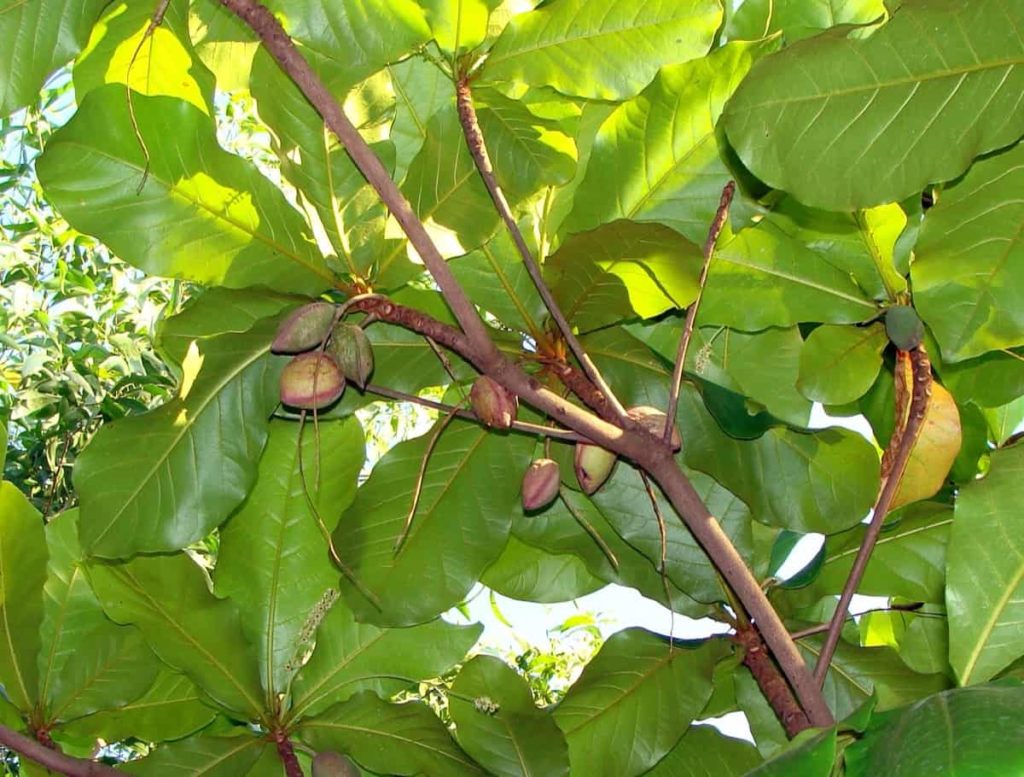
Conclusion
In the United States, the best climate for growing Almond trees can be found in Central California. There are other suitable areas (Arizona, Texas, and parts of Georgia), but as a rule, the risk of fungal diseases increases as they move to the east. In addition, global growth in protein demand has been a boon for tree nuts in general and Almonds in particular. Therefore, the Almond industry is growing rapidly in the US. The above conditions are helpful to starting Almond farming in the USA.
- Economical Aquaculture: A Guide to Low-Budget Fish Farming
- 15 Common Planting Errors That Can Doom Your Fruit Trees
- How to Make Houseplants Bushy: Effective Tips and Ideas
- Innovative Strategies for Boosting Coconut Pollination and Yield
- Pollination Strategies for Maximum Pumpkin Yield
- The Complete Guide to Chicken Fattening: Strategies for Maximum Growth
- Natural Solutions for Tulip Problems: 100% Effective Remedies for Leaf and Bulb-Related Issues
- Revolutionizing Citrus Preservation: Towards a Healthier, Greener Future
- Natural Solutions for Peony Leaf and Flower Problems: 100% Effective Remedies
- Maximizing Profits with Avocado Contract Farming in India: A Comprehensive Guide
- Natural Solutions for Hydrangea Problems: 100% Effective Remedies for Leaf and Flowers
- The Ultimate Guide to Choosing the Perfect Foliage Friend: Bringing Life Indoors
- From Sunlight to Sustainability: 15 Ways to Use Solar Technology in Agriculture
- The Ultimate Guide to Dong Tao Chicken: Exploring from History to Raising
- The Eco-Friendly Makeover: How to Convert Your Unused Swimming Pool into a Fish Pond
- Mastering the Art of Delaware Chicken Farming: Essentials for Healthy Backyard Flocks
- 20 Best Homemade Fertilizers for Money Plant: DIY Recipes and Application Methods
- How to Craft a Comprehensive Free-Range Chicken Farming Business Plan
- Brighten Your Flock: Raising Easter Egger Chickens for Beauty and Bounty
- How to Optimize Your Poultry Egg Farm Business Plan with These Strategies
- Subsidy for Spirulina Cultivation: How Indian Government Schemes Encouraging Spirulina Farmers
- Ultimate Guide to Raising Dominique Chickens: Breeding, Feeding, Egg-Production, and Care
- Mastering the Art of Raising Jersey Giant Chickens: Care, Feeding, and More
- Ultimate Guide to Raising Legbar Chickens: Breeding, Farming Practices, Diet, Egg-Production
- How to Raise Welsummer Chickens: A Comprehensive Guide for Beginners
- How to Protect Indoor Plants in Winter: A Comprehensive Guide
- Ultimate Guide to Grow Bag Gardening: Tips, Tricks, and Planting Ideas for Urban Gardeners
- Guide to Lotus Cultivation: How to Propagate, Plant, Grow, Care, Cost, and Profit
- Agriculture Drone Subsidy Scheme: Government Kisan Subsidy, License, and How to Apply Online
- Ultimate Guide to Raising Araucana Chickens: Breed Profile, Farming Economics, Diet, and Care
- Bringing Hydroponics to Classroom: Importance, Benefits of Learning for School Students
- Ultimate Guide to Raising Polish Chickens: Breed Profile, Farming Economics, Diet, and Care
- Ultimate Guide to Raising Australorp Chickens: Profile, Farming Economics, Egg Production, Diet, and Care
- Silkie Chicken Farming: Raising Practices, Varieties, Egg Production, Diet, and Care
- Sussex Chicken Farming: Raising Practices, Varieties, Egg Production, Diet and Care
- Homemade Feed Formulations for Livestock: Discover Cost-effective Starter to Finisher Feed Recipes